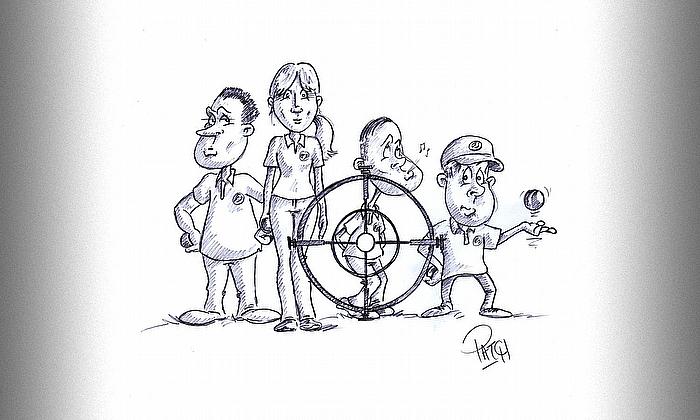Managing the Marked Bowler

However good your bowling unit is, there will always be one bowler identified as the weakest link, and good sides will always try to make the most of these overs.
The commentators made numerous mentions in the India vs England World Cup match on Sunday 30th June that Hardyk Pandya was the weak link in the Indian bowling attack. It got us thinking about how the captain can deal with this particular bowler and how can they get the best out of them in the match.
Your weakest bowler on any given day might well be different given the pitch, weather conditions, size of boundary, etc.. In this World Cup, England have not played Moeen Ali in a couple of games in part due to the shortness of one or more of the boundaries. Not all teams have the luxury of resting a player as talented as Moeen, so in school or club circumstances, whatever the conditions, you will generally play the best XI available. The best sides will therefore know which bowlers they can look to get after and unsettle from the start. If the bowler is aware of the situation and has a good understanding of the game, they will also identify that it will be them that is likely to face an aggressive approach from the batters.
A lot will depend on the character of the player in these circumstances, but the captain has a role here to help with confidence and also protect his player as much as possible.
An understanding of the ground dimensions and taking into account the wind direction as a captain is important when deciding on which end your marked bowler bowls. For example, in asking an off spin bowler to bowl into the wind with short straight and leg side boundaries, you are inviting carnage. Give the bowler a little protection with the wind behind them, so the batter is hitting into the wind. Also try to give the off spin bowler the longer leg side boundary for some protection.
When you have identified at which end your marked bowler should bowl, you will need to consider how you can get the necessary amount of overs out of the bowler for the minimum of damage. It may well be that the bowler in question needs to bowl several short spells at low risk moments throughout the innings. For example, if you find yourself in a situation where there are two new batters at the crease, this is a great time to try to get a few overs out of the way.
The danger of waiting, though, is that this situation may not arise and you find yourself in a position of having to bowl the bowler the opposition are looking to target at precisely the point in the innings where they are looking to accelerate, which, again, could spell disaster. If your bowler can get a couple of good overs out of the way at the start of the innings, where openers may be less likely to go hard from the first over, you can often get two overs out of the way then. If you spot a slower or more watchful batter and you find them on strike at the start of an over in a relatively quiet period of the game, you may be able to steal another over here. This will be the way throughout the innings, always looking for a good opportunity to get an over or two out the way.
This approach all sounds very negative, and in doing so, it may be that the bowler’s confidence wanes and self-expectation becomes low. In a positive slant, you should try to get the bowler to see that in a batter targeting a bowler, by definition they will be taking more chances and playing with increased risk. If you as captain can work out where each batter is looking to score and set the field accordingly, it will be likely that you create chances. If identified as the weaker bowler, it is important that he or she understands whilst they may go for a few runs, the chances of taking a wicket and breaking an important partnership may well be increased.
Always give the bowler your vote of confidence that you think they will be the one to create a chance and give them a boost to their confidence. Every bowler likes to feel that their captain has them in their plan and to know that whilst they may go for a few runs, the belief is there that the chance will come off their bowling. The best part of all will be to see the batters face as they walk off in utter disgust at themselves! Have a look at these, which are evidence that a weaker bowler can induce a rash shot or a lapse in concentration…
AB DeVilliers, Dhoni, Gilchrist as wicket-takers
https://www.youtube.com/watch?v=xv1y9nU5lwA
AB DeVilliers wicket taker vs New Zealand
https://www.youtube.com/watch?v=fMT45TCGTMY
Michael Atherton gets Graham Gooch
https://www.youtube.com/watch?v=cZnrYYsJnWI
Top order batters breaking partnerships
https://www.youtube.com/watch?v=-UyoQYFVHiQ
Good luck!
PL & WD
Cricket: A Leading Edge for Captains is available as a paperback (£12.99) and eBook (£3.99) from Amazon.co.uk. Books are also from Walkers Bookshops in Oakham and Stamford, and from CM Cricket in Stoughton, Leicester.




